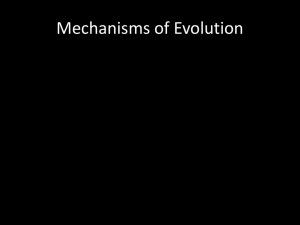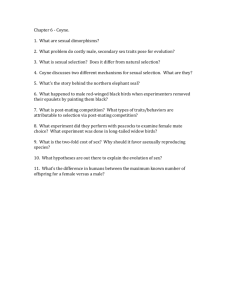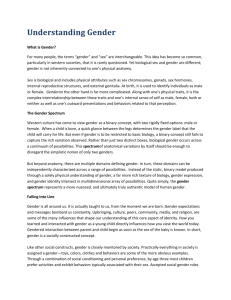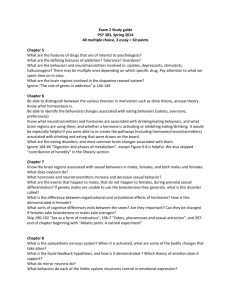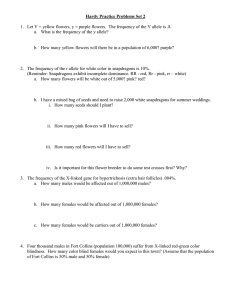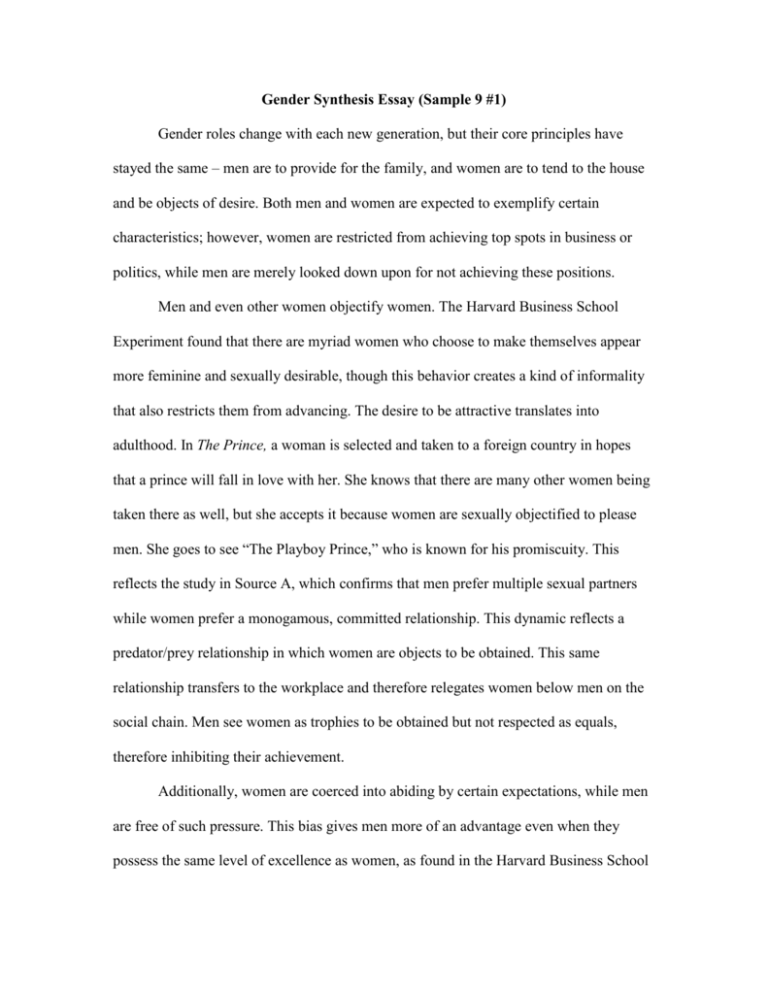
Gender Synthesis Essay (Sample 9 #1)
Gender roles change with each new generation, but their core principles have
stayed the same – men are to provide for the family, and women are to tend to the house
and be objects of desire. Both men and women are expected to exemplify certain
characteristics; however, women are restricted from achieving top spots in business or
politics, while men are merely looked down upon for not achieving these positions.
Men and even other women objectify women. The Harvard Business School
Experiment found that there are myriad women who choose to make themselves appear
more feminine and sexually desirable, though this behavior creates a kind of informality
that also restricts them from advancing. The desire to be attractive translates into
adulthood. In The Prince, a woman is selected and taken to a foreign country in hopes
that a prince will fall in love with her. She knows that there are many other women being
taken there as well, but she accepts it because women are sexually objectified to please
men. She goes to see “The Playboy Prince,” who is known for his promiscuity. This
reflects the study in Source A, which confirms that men prefer multiple sexual partners
while women prefer a monogamous, committed relationship. This dynamic reflects a
predator/prey relationship in which women are objects to be obtained. This same
relationship transfers to the workplace and therefore relegates women below men on the
social chain. Men see women as trophies to be obtained but not respected as equals,
therefore inhibiting their achievement.
Additionally, women are coerced into abiding by certain expectations, while men
are free of such pressure. This bias gives men more of an advantage even when they
possess the same level of excellence as women, as found in the Harvard Business School
Experiment. Men placed expectations on women and objectified them through several
social interactions such as the game “kill, sleep with or marry” mentioned in the article.
This seemingly harmless game confirms the social expectation that women exist to meet
men’s needs and anything beyond that is unnecessary. Source D states that even if
women overcome these social expectations, they will still suffer from “unconscious bias”
placed upon them by their coworkers and employers. This stigma forces women to meet
standards that are nonexistent in the male social environment.
Men are also affected by gender bias; they are expected to achieve success and
when they do not achieve success they are look down upon. For example, when my father
stopped working in order to be a stay at home dad and my mom became the sole
provider, my father’s parents shunned my parents because they were embarrassed that
their son was not providing for his family. This example is a case where gender bias did
affect a man negatively because his decision to place child rearing above employment
was questioned. However, after three months everyone was on speaking terms again,
showing that the gender taboo was not permanent, and society has progressed as my
grandparents did.
Men are not as restricted as women are. They may be looked down upon for not
achieving success in the occupational world; however, they have the ability to achieve
these top positions and are not constrained by gender roles. Women, on the other hand,
suffer from restrictions placed on them through societal pressures. Societal expectations
favor men, perpetuating the superiority of men.
Gender Synthesis Essay (Sample 9 #2)
An article called “The Ten Manliest Meals in America” is written annually for a
magazine primarily ‘geared towards men’. The author goes around the country every year
looking for restaurants that serve what he can call masculine and proceeds to write about
ten of them in usually just under two thousand words. So, what makes a meal ‘manly’?
What lucky dishes pass his tests, meet his standards? According to the articles, there are
seem to be few qualities that do just this: fleshy, meaty, crudely represented, tough to
chew through, etc.1 Does this in turn, though, mean that there are inherently opposite and
therefore feminine foods? Ones that are delicate, fragrant, and leafy perhaps? These ideas
about definitionally non-gendered entities reflect the stereotypes we have of gender
today. Men and women, though stereotyped in different ways, are equally restricted in
society.2
3
The most commonly talked-about stereotypes have to do with sexuality and
sexual activity. Source C explains a social experiment that resulted in males outwardly
expressing a comfort with having tens of new and unknown sexual partners that not a
trace of could be found in females. This idea that “males prefer to have anonymous sex
with strange women” (C) is a major gender-based stereotype in society. However, though
sometimes tossed aside, there are sexual biases directed at women as well. These are
what created the notion of the perfect womanly body that empowers the eating disorders
that are eating away at today’s youth, as proven in Source E. Unnecessary
1
I added this part about what the author and I think makes food manly to make the reader think of
the stereotype I’m describing.
2 I changed my thesis to make more sense. My original thesis was messy and unclear.
3 This entire paragraph is entirely different from one I wrote originally. I changed a good majority of
this essay because of the lack of focus I initially wrote it with.
3The paragraph is here to get the reader thinking about stereotype he or she may actually believe
and definitely ones they know about.
standardizations of masculin- and feminin-ity bolster biased behavior and belief toward
both men and women. Either put down for or respected for extra sexual activity, females
and males are bound socially to uphold a standard that, if not kept, ostracizes them from
any position or social standing entirely. Males must have many partners, regardless of
their desire for them, to enhance their reputation; females must not have any
supplementary suitors, regardless of their desire for them, to keep up a collected and
thoughtful image. Though held to different principles, men and women deal with
attempting to reach equal but distinct and unattainable goals of sexual perfection.
Fundamentally and biologically, females and males are very different beings.
Source A simply explains the very basic differences between the two with a concise, “If
you were born with one set of parts you’re considered male, and if you were born with
another set of parts you’re considered female.” There’s a lot more to it than that, but
essentially, we’re just different.4 We have similar shapes and sometimes we look the
same on the outside, but inside we’re distinct. For example, in the face of danger, females
produce acetylcholine (ACTL) and men produce adrenaline. ACTL increases brain
activity, lowers heart rate, and inhibits excited actions; adrenaline releases more sugar
into the blood and increases energy. There are several stereotypes based on that
distinction alone including ones that make women out to be the weaker and men the
stronger, as well as ones that idealize women as the rational counter to the male’s
senseless attack. Sources F and H (second cartoon) both corroborate these examples of
gender biases. Source F states that there are “...social science studies that suggest women
demonstrate an aversion to risk-taking,” while Source H implies that men were originally
4 This quote and reference to Source A is added to emphasize the differences in male and female
anatomy.
elected into power because of their assumed strength and are now being taken over by the
more thoughtful women.5 There are numerous accusations made against both sexes, and,
though different, provide both with a similar range of hindrances.
Some flowers, though a majority are sexually complete systems in and of
themselves, do have biologically determined sexes, just as animals do. Examples of these
gendered flowers are vegetables such as zucchini and squash. We eat the males. The only
thing nature itself uses the males for is pollinating their female counterparts. After they
complete that they’re virtually useless, and we don’t eat the female flowers because
they’re needed for later fruit development and production. The biological factors that
went into how we see and how we handle gendered flowers directly relates to how we
handle our social relationships today.6 Without minimizing the significance of sexual
stereotyping, the concept itself was inevitable due to inherent distinctions and is equal on
both extremes (male and female). There are different biases towards men and women that
reflect biologically based ideals. Both females and males are unfortunately tremendously
and equally pigeonholed in the world today.
5 This interpretation of the political cartoon in Source H is added to provide more analyzation and
reference to the sources given.
6 This flower imagery that turns into a metaphor later on is added to give more outside information
and more light and colorful images to the reader.
6Flowers don’t seem like the kind of thing a person could compare another person to, so I decided I’d
try.




